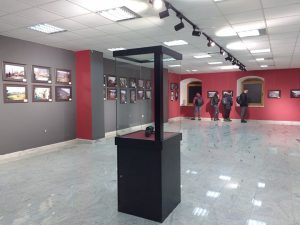

A doctor from Kosovo, Enver Hoxha, shares his personal photo collection from his time as an aid worker during the Kosovo war in his first exhibition at the National Museum of Kosovo, ‘Genocide XX.’
According to medical doctor, plastic surgeon and amateur photographer Enver Hoxha, his first photographic exhibition could not have come at a more crucial time.
Speaking with Prishtina Insight on Wednesday as he walked around his exhibition ‘Genocide XX’ (which is showing at the ground floor of the National Museum of Kosovo until Sunday, December 15), Hoxha says that his private collection of around 100 pictures taken across four months during the Kosovo war have become a direct response to claims made by Serbian President Aleksandar Vucic last week.
“President Vucic denied the existence of the Recak massacre, he denied the crimes that were committed here in Kosovo,” said Hoxha. Vucic on Thursday accused the former head of the OSCE Kosovo Verification Mission, William Walker, of faking the Recak massacre, which took place in January 1999.
According to Hoxha, his exhibition, which was organized to coincide with the International Day of Commemoration of the Victims of Genocide, is a testament to all of the real and devastating effects of the war in Kosovo.
“The theme of the exhibition is that we should remember the past, but also build towards the future,” he said. “Many young people who were born after the war are visiting the exhibition, people who want to see and understand what happened.”
Hoxha worked giving medical aid to people who became displaced during the conflict. According to him, because of the events he witnessed, his hobby of taking photographs instead became an obligation. “A picture can speak a thousand words,” he said. “I wanted to give something real to history, something to remember what my people, and myself, went through.”

The exhibition documents the journey of several groups of people across Kosovo chronologically from March to June 1999. It begins with pictures of caravans of people making their way across the country seeking medical aid and shelter.
“The timeline in which these photos were taken begins with the time that NATO started bombing. At this time, the [Yugoslav] army began a tough offensive against Albanians as a counter-attack, it was the peak of the Serbian offensive that targeted Albanian civilians, forcing them to leave the country,” Hoxha explained.
The title of the exhibition, Genocide XX, has more than one meaning, the doctor explained. “Firstly, it represents the 20th anniversary of the massacres in Kosovo. It also references that this is a chance to reflect on the entire 20th century, during which Albanians have suffered through numerous wars and massacres of which there was no possibility to document,” he explained. “Finally, the symbol ‘X’ represents the unknown. Even today, we do not know whether many of the people who committed these massacres, these terrors, will ever be judged or given true punishment.”
The exhibition ends with a series of photos that graphically depict victims of the war discovered by Hoxha, at the location in which they died.
He believes that it is important for exhibitions like this to tell the whole story. “The reactions to these pictures have been very multidimensional,” he said. “Serbia conducted massacres and created terror in order to force people to leave. It is important for people to understand the context, the complete situation and see the consequences. I owe this to the victims, their families and to the others in these pictures. We have to remember the past, even if it is quite terrible.”
2019 has been marked by numerous exhibitions across Kosovo dedicated to commemorating the victims of the Kosovo war. The exhibition ‘Once upon a time and never again,’ which will be shown at the Hivzi Sylejmani library in the Dardania neighborhood of Prishtina until May 2020, exhibits the pictures, stories and personal belongings of children who were killed during the war.
The exhibition ‘Genocide XX’ will continue to be shown on the ground floor of the National Museum of Kosovo in Prishtina until Sunday, December 15. Entry is free of charge.
11 December 2019 - 16:23